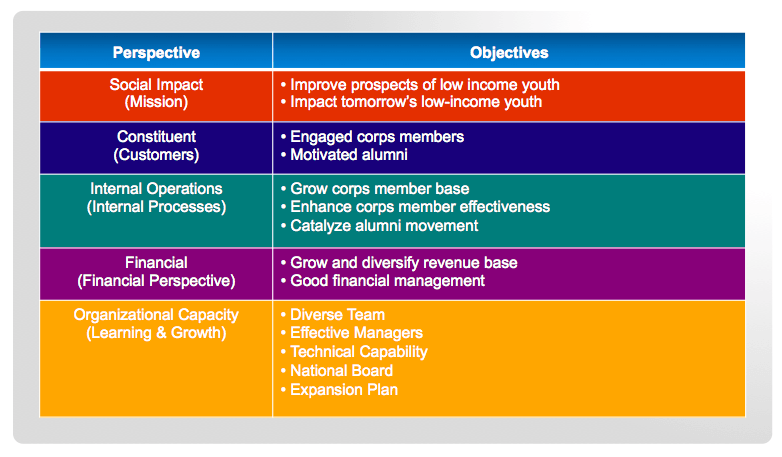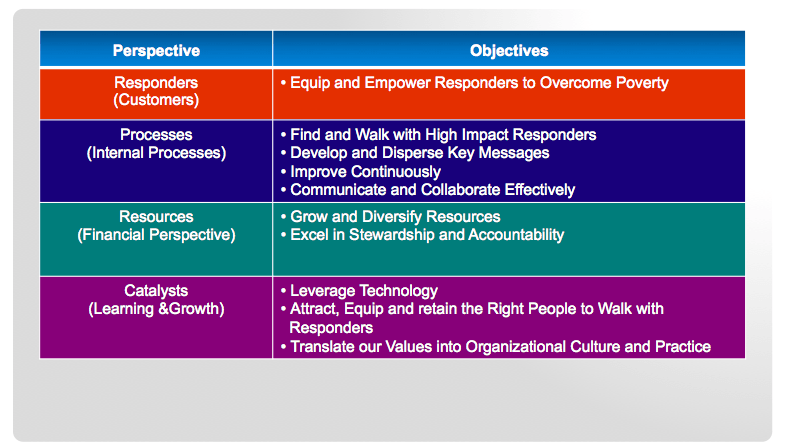In this extensive article, we’ll walk through how to create and write out your strategic objectives—and give some examples along the way. (Note that many of the examples below are from a nonprofit angle. There is so much written from a for-profit orientation, so we thought this would be helpful to a broader audience.)
How To Create & Write Out Your Strategic Objectives
1. Choose objectives based on your strategy, not your industry.
Just because you are in the same industry doesn’t mean you have the same strategy. So, you may not have the same objectives as others in your industry. For example, financial institutions like Ally or E*Trade focus on leveraging customer-focused technology, so their objectives are likely focused on having user-friendly software and developing tools that will help their customers. Financial institutions like Goldman Sachs or Merrill Lynch focus on leveraging personal relationships, so their objectives are likely focused on providing excellent customer service or developing personal relationships.Ready to see strategic success in your company? It’s time to put the Balanced Scorecard to work.
Thus, you should base your strategic objectives on your strategy—not another organization’s strategy.2. Consider all four “perspectives” when creating strategic objectives.
The Balanced Scorecard has four perspectives—financial, customer, internal processes, and people (learning and growth). If you have 10-15 strategic objectives, they shouldn’t all fall into just one of those perspectives. Instead, they should be (at least somewhat) evenly distributed among the four.3. Follow the “Verb + Adjective + Noun” format.
The typical format of a strategic objective is “Verb + Adjective + Noun.” If you use this formula, your strategic objectives will create an action statement.
Note that your strategic objectives should describe your strategy—not just a typical strategy. For example, a nonprofit may consider their approach to fundraising and come up with the following objectives:

4. Create “strategic objective statements” that clarify intent.
Sometimes a three- to five-word strategic objective isn’t enough information for those who are not in the room when the objective is decided or someone who isn’t on the leadership team. So, you need to write objective statements—no more than 2-3 sentences each—that clarify the objective’s intent and meaning.For example, if the objective is “Increase event-driven fundraising,” the objective statement might be:
“We will develop a world-class website that makes it easy for donors to interact with us. We will do this by partnering with an outside web development firm.”The objective statement should describe what the objective means and how it will be accomplished.
5. Follow these guidelines for developing strategic objectives.
- You should have no more than 15 objectives in your strategy.
- Objectives should link together as a group in a logical way. In other words, you shouldn’t have one objective that states “Develop interpersonal relationships,” and another that states, “Migrate everyone to an online support system.” Those objectives would drive different behaviors. So you want to be sure that all of your objectives work together in a way that reflects your strategy.
- Every objective must have at least a verb and a noun:
- Good: Improve fundraising.
- Bad: Fundraising.
- Make sure you aren’t including “projects” as objectives.
- Good: Improve communication with donors.
- Bad: Implement CRM.
- Note that customer perspective objectives can be in the “voice of the customer.”
- Example: “Help me find appropriate housing options.”
Examples Of Common Strategic Objectives
Financial- Diversify donor mix.
- Drive financial stability.
- Improve resource management.
- Demonstrate market returns on endowment.
- “We want affordable healthcare.”
- “We want reliable sources of food.”
- “We want dependable services.”
- Maximize community impact.
- Improve program development process.
- Rationalize programs.
- Develop fundraising options.
- Drive policy changes.
- Improve headquarter productivity.
- Improve volunteer leadership capabilities.
- Modernize technology infrastructure.
- Enhance board involvement.
- Drive a performance-focused culture.
- Attract top talent.
Case Example: Teach For America
About 10 years ago, Teach For America created a Balanced Scorecard—and this case example represents their objectives and strategy at the time. (Note that some of the objectives have been simplified.)
Case Example: Food For The Hungry
This Food for the Hungry case example is pulled from a book author Paul Niven wrote in 2008, “Balanced Scorecard: Step-by-Step for Government and Nonprofit Agencies.”
Get Started
The best way to get started with writing out your strategic objectives is to ask yourself these key questions.- Financial: What is your key financial goal?
- Customers: What should your customers say about your organization?
- Internal: What processes are most critical to your success?
- Learning & Growth: What can you focus on to make your employees more effective?
- Use the Verb + Adjective + Noun structure.
- Write two- to three-sentence objective statements for each objective.
In Conclusion
Creating strategic objectives is a great way to prepare those in your organization for being able to talk about your strategy consistently and coherently. Ultimately, you’ll also need to create and write out measures and projects in order to manage your strategy.If you’d like to view additional strategy maps with sample objectives from a bank, a manufacturing company, a software company, and an insurance company, download the free ebook below.
https://www.clearpointstrategy.com/













No comments:
Post a Comment